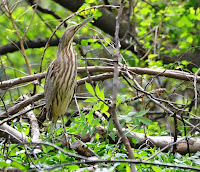AMERICAN BITTERN
AMERICAN BITTERN – (Botaurus lentiginosus) – (See images below)
DESCRIPTION: The American Bittern is a heron with variegated plumage of brown and beige and white, which makes it almost invisible. The breast is beige with brown stripes. The eyes are yellow, and the bill is long and pointed. The bill, legs and feet are yellowish green. The bird is around 80 cm (32 in.) long.
VOICE: https://www.xeno-canto.org/species/Botaurus-lentiginosus – This bird’s main call is a deep three-syllable sound made from air stored in the oesophagus.
NAME: The bird’s name (both English and Latin) refers to the ‘bull-like’ call of the breeding male. The Latin species name ‘lentiginosus’ relates to the ‘freckled’ aspect of the bird’s plumage.
HABITAT: Marshland with tall vegetation.
DIET: Hunts for fish by stalking or waiting for the prey to reach striking distance from its powerful bill. Also preys on small reptiles and mammals, and invertebrates.
NESTING: The nest is built on the ground in thick vegetation that grows on (or near) the water. Around three to six beige eggs are laid, which are incubated by the female. The young are fed by the female.
DISTRIBUTION: This bird’s breeding range encompasses most of the Canadian provinces up to the tree line except Yukon, and the northern part of the USA (except Alaska). It winters in the south part of the USA, Mexico and Cuba for the most part. Some individuals have also been found in Hawaii. (See note below for information on bird vagrancy.)
ON PEI: The American bittern breeds on Prince Edward Island and is fairly common except in winter.
CONSERVATION: The population of this heron species has declined due to habitat loss from pollutants and development. However it is still not considered at risk thanks to its large range.
NOTES: The American bittern is a very well camouflaged bird and hard to see if it doesn’t move. However it is easy to locate one from the calls males make to claim territory and attract mates. It blends in well with the thick vegetation when it adopts its alarmed pose with the bill upright. It is a solitary bird.
Vagrancy: In biology this means an animal going way outside its normal range. For birds, this can happen when there are storms and they get blown off course. On other times, the bird simply wanders in a different direction than usual. Here’s an article about vagrancy in birds.
SIMILAR SPECIES: Black-crowned Night Heron (juvenile), Least Bittern
REFERENCES: https://www.borealbirds.org/bird/american-bittern
https://www.mba-aom.ca/jsp/toc.jsp (Maritimes Breeding Bird Atlas)
http://www.env.gov.bc.ca/okanagan/esd/atlas/species/bittern.html
https://www.dec.ny.gov/animals/85197.html
http://www.birdweb.org/birdweb/bird/american_bittern
https://www.audubon.org/field-guide/bird/american-bittern
https://www.allaboutbirds.org/guide/American_Bittern/id
https://en.wikipedia.org/wiki/American_bittern
http://www.nhptv.org/natureworks/americanbittern.htm (New Hampshire PBS)
DESCRIPTION: The American Bittern is a heron with variegated plumage of brown and beige and white, which makes it almost invisible. The breast is beige with brown stripes. The eyes are yellow, and the bill is long and pointed. The bill, legs and feet are yellowish green. The bird is around 80 cm (32 in.) long.
VOICE: https://www.xeno-canto.org/species/Botaurus-lentiginosus – This bird’s main call is a deep three-syllable sound made from air stored in the oesophagus.
NAME: The bird’s name (both English and Latin) refers to the ‘bull-like’ call of the breeding male. The Latin species name ‘lentiginosus’ relates to the ‘freckled’ aspect of the bird’s plumage.
HABITAT: Marshland with tall vegetation.
DIET: Hunts for fish by stalking or waiting for the prey to reach striking distance from its powerful bill. Also preys on small reptiles and mammals, and invertebrates.
NESTING: The nest is built on the ground in thick vegetation that grows on (or near) the water. Around three to six beige eggs are laid, which are incubated by the female. The young are fed by the female.
DISTRIBUTION: This bird’s breeding range encompasses most of the Canadian provinces up to the tree line except Yukon, and the northern part of the USA (except Alaska). It winters in the south part of the USA, Mexico and Cuba for the most part. Some individuals have also been found in Hawaii. (See note below for information on bird vagrancy.)
ON PEI: The American bittern breeds on Prince Edward Island and is fairly common except in winter.
CONSERVATION: The population of this heron species has declined due to habitat loss from pollutants and development. However it is still not considered at risk thanks to its large range.
NOTES: The American bittern is a very well camouflaged bird and hard to see if it doesn’t move. However it is easy to locate one from the calls males make to claim territory and attract mates. It blends in well with the thick vegetation when it adopts its alarmed pose with the bill upright. It is a solitary bird.
Vagrancy: In biology this means an animal going way outside its normal range. For birds, this can happen when there are storms and they get blown off course. On other times, the bird simply wanders in a different direction than usual. Here’s an article about vagrancy in birds.
SIMILAR SPECIES: Black-crowned Night Heron (juvenile), Least Bittern
REFERENCES: https://www.borealbirds.org/bird/american-bittern
https://www.mba-aom.ca/jsp/toc.jsp (Maritimes Breeding Bird Atlas)
http://www.env.gov.bc.ca/okanagan/esd/atlas/species/bittern.html
https://www.dec.ny.gov/animals/85197.html
http://www.birdweb.org/birdweb/bird/american_bittern
https://www.audubon.org/field-guide/bird/american-bittern
https://www.allaboutbirds.org/guide/American_Bittern/id
https://en.wikipedia.org/wiki/American_bittern
http://www.nhptv.org/natureworks/americanbittern.htm (New Hampshire PBS)
 |
| American Bittern, Tower Grove Photo by Andy Reago and Chrissy McClarren |
 |
| American bittern in flight Photo by Ken Sturm, USFWS |